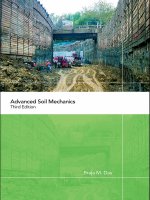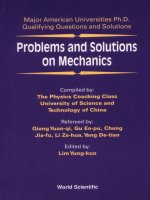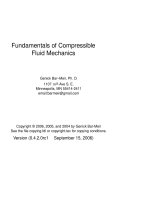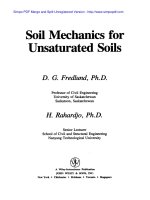Advanced Soil Mechanics doc
Bạn đang xem bản rút gọn của tài liệu. Xem và tải ngay bản đầy đủ của tài liệu tại đây (3.35 MB, 594 trang )
Advanced Soil Mechanics
Advanced Soil Mechanics
Third edition
Braja M. Das
First published 1983 by Hemisphere Publishing Corporation and McGraw-Hill
Second edition published 1997 by Taylor & Francis
This edition published 2008 by Taylor & Francis
270 Madison Ave, New York, NY 10016, USA
Simultaneously published in the UK
by Taylor & Francis
2 Park Square, Milton Park, Abingdon, Oxon OX14 4RN
Taylor & Francis is an imprint of the Taylor & Francis Group, an informa business
© 2008 Braja M. Das
Cover Credit Image:
Courtesy of Subsurface Constructors, Inc., St. Louis, Missouri, U.S.A.
All rights reserved. No part of this book may be reprinted or reproduced or
utilised in any form or by any electronic, mechanical, or other means, now
known or hereafter invented, including photocopying and recording, or in
any information storage or retrieval system, without permission in writing
from the publishers.
Library of Congress Cataloging in Publication Data
A catalog record for this book has been requested
British Library Cataloguing in Publication Data
A catalogue record for this book is available from the British Library
ISBN10: 0–415–42026–1 (hbk)
ISBN10: 0–203–93584–5 (ebk)
ISBN13: 978–0–415–42026–6 (hbk)
ISBN13: 978–0–203–93584–2 (ebk)
This edition published in the Taylor & Francis e-Library, 2007.
“To purchase your own copy of this or any of Taylor & Francis or Routledge’s
collection of thousands of eBooks please go to www.eBookstore.tandf.co.uk.”
ISBN 0-203-93584-5 Master e-book ISBN
To our granddaughter, Elizabeth Madison
Contents
List of Tables xii
List of Figures xiv
Preface xxv
1 SOIL AGGREGATE, PLASTICITY, AND
CLASSIFICATION
1
1.1 Introduction 1
1.2 Soil—separate size limits 1
1.3 Clay minerals 3
1.4 Nature of water in clay 7
1.5 Repulsive potential 10
1.6 Repulsive pressure 15
1.7 Flocculation and dispersion of clay particles 17
1.8 Consistency of cohesive soils 19
1.9 Liquidity index 25
1.10 Activity 25
1.11 Grain-size distribution of soil 28
1.12 Weight–volume relationships 30
1.13 Relative density and relative compaction 36
1.14 Effect of roundness and nonplastic fines on e
max
and e
min
for
granular soils 37
1.15 Unified soil classification system 40
2 STRESSES AND STRAINS—ELASTIC
EQUILIBRIUM
47
2.1 Introduction 47
2.2 Basic definition and sign conventions for stresses 47
2.3 Equations of static equilibrium 49
2.4 Concept of strain 55
viii Contents
2.5 Hooke’s law 57
2.6 Plane strain problems 58
2.7 Equations of compatibility for three-dimensional problems 64
2.8 Stresses on an inclined plane and principal stresses for plane strain
problems 65
2.9 Strains on an inclined plane and principal strain for plane strain
problems 75
2.10 Stress components on an inclined plane, principal stress, and
octahedral stresses—three-dimensional case 76
2.11 Strain components on an inclined plane, principal strain, and
octahedral strain—three-dimensional case 85
3 STRESSES AND DISPLACEMENTS IN A SOIL
MASS
87
3.1 Introduction 87
TWO-DIMENSIONAL PROBLEMS
3.2 Vertical line load on the surface 87
3.3 Vertical line load on the surface of a finite layer 92
3.4 Vertical line load inside a semi-infinite mass 93
3.5 Horizontal line load on the surface 95
3.6 Horizontal line load inside a semi-infinite mass 96
3.7 Uniform vertical loading on an infinite strip on the surface 97
3.8 Uniform strip load inside a semi-infinite mass 103
3.9 Uniform horizontal loading on an infinite strip on the surface 103
3.10 Triangular normal loading on an infinite strip on the surface 106
3.11 Vertical stress in a semi-infinite mass due to embankment loading 108
THREE-DIMENSIONAL PROBLEMS
3.12 Stresses due to a vertical point load on the surface 112
3.13 Deflection due to a concentrated point load at the surface 115
3.14 Horizontal point load on the surface 115
3.15 Stresses below a circularly loaded flexible area (uniform
vertical load) 116
3.16 Vertical displacement due to uniformly loaded circular area at
the surface 126
3.17 Vertical stress below a rectangular loaded area on the surface 130
3.18 Deflection due to a uniformly loaded flexible rectangular area 135
3.19 Stresses in a layered medium 136
3.20 Vertical stress at the interface of a three-layer flexible system 139
3.21 Distribution of contact stress over footings 142
3.22 Reliability of stress calculation using the theory of elasticity 144
Contents ix
4 PORE WATER PRESSURE DUE TO
UNDRAINED LOADING
150
4.1 Introduction 150
4.2 Pore water pressure developed due to isotropic stress application 151
4.3 Pore water pressure parameter B 153
4.4 Pore water pressure due to uniaxial loading 156
4.5 Directional variation of A
f
159
4.6 Pore water pressure under triaxial test conditions 161
4.7 Henkel’s modification of pore water pressure equation 162
4.8 Pore water pressure due to one-dimensional strain loading
(oedometer test) 166
5 PERMEABILITY AND SEEPAGE 170
5.1 Introduction 170
PERMEABILITY
5.2 Darcy’s law 170
5.3 Validity of Darcy’s law 173
5.4 Determination of coefficient of permeability in the laboratory 175
5.5 Variation of coefficient of permeability for granular soils 179
5.6 Variation of coefficient of permeability for cohesive soils 187
5.7 Directional variation of permeability in anisotropic medium 191
5.8 Effective coefficient of permeability for stratified soils 195
5.9 Determination of coefficient of permeability in the field 199
5.10 Factors affecting the coefficient of permeability 206
5.11 Electroosmosis 206
SEEPAGE
5.12 Equation of continuity 210
5.13 Use of continuity equation for solution of simple flow problem 214
5.14 Flow nets 217
5.15 Hydraulic uplift force under a structure 221
5.16 Flow nets in anisotropic material 223
5.17 Construction of flow nets for hydraulic structures on
nonhomogeneous subsoils 227
5.18 Numerical analysis of seepage 230
5.19 Seepage force per unit volume of soil mass 239
5.20 Safety of hydraulic structures against piping 240
5.21 Filter design 248
5.22 Calculation of seepage through an earth dam resting on an
impervious base 250
5.23 Plotting of phreatic line for seepage through earth dams 262
x Contents
5.24 Entrance, discharge, and transfer conditions of line of seepage
through earth dams 263
5.25 Flow net construction for earth dams 264
6 CONSOLIDATION 276
6.1 Introduction 276
6.2 Theory of one-dimensional consolidation 278
6.3 Degree of consolidation under time-dependent loading 296
6.4 Numerical solution for one-dimensional consolidation 300
6.5 Standard one-dimensional consolidation test and interpretation 310
6.6 Effect of sample disturbance on the e versus log
curve 316
6.7 Secondary consolidation 317
6.8 General comments on consolidation tests 321
6.9 Calculation of one-dimensional consolidation settlement 325
6.10 Coefficient of consolidation 327
6.11 One-dimensional consolidation with viscoelastic models 336
6.12 Constant rate-of-strain consolidation tests 342
6.13 Constant-gradient consolidation test 348
6.14 Sand drains 352
6.15 Numerical solution for radial drainage (sand drain) 361
6.16 General comments on sand drain problems 364
7 SHEAR STRENGTH OF SOILS 373
7.1 Introduction 373
7.2 Mohr–Coulomb failure criteria 373
7.3 Shearing strength of granular soils 374
7.4 Critical void ratio 384
7.5 Curvature of the failure envelope 385
7.6 General comments on the friction angle of granular soils 387
7.7 Shear strength of granular soils under plane strain condition 388
7.8 Shear strength of cohesive soils 392
7.9 Unconfined compression test 405
7.10 Modulus of elasticity and Poisson’s ratio from triaxial tests 406
7.11 Friction angles and
cu
408
7.12 Effect of rate of strain on the undrained shear strength 408
7.13 Effect of temperature on the undrained shear strength 411
7.14 Stress path 413
7.15 Hvorslev’s parameters 423
7.16 Relations between moisture content, effective stress, and strength
for clay soils 426
7.17 Correlations for effective stress friction angle 431
7.18 Anisotropy in undrained shear strength 433
7.19 Sensitivity and thixotropic characteristics of clays 436
Contents xi
7.20 Vane shear test 441
7.21 Relation of undrained shear strength S
u
and effective overburden
pressure p
445
7.22 Creep in soils 450
7.23 Other theoretical considerations—yield surfaces in three
dimensions 457
7.24 Experimental results to compare the yield functions 463
8 SETTLEMENT OF SHALLOW
FOUNDATIONS
477
8.1 Introduction 477
ELASTIC SETTLEMENT
8.2 Modulus of elasticity and Poisson’s ratio 477
8.3 Settlement based on theory of elasticity 484
8.4 Generalized average elastic settlement equation 493
8.5 Improved equation for elastic settlement 495
8.6 Calculation of elastic settlement in granular soil using simplified
strain influence factor 501
CONSOLIDATION SETTLEMENT
8.7 One-dimensional primary consolidation settlement calculation 506
8.8 Skempton–Bjerrum modification for calculation of consolidation
settlement 511
8.9 Settlement of overconsolidated clays 516
8.10 Settlement calculation using stress path 517
8.11 Comparison of primary consolidation settlement calculation
procedures 523
8.12 Secondary consolidation settlement 524
8.13 Precompression for improving foundation soils 525
Appendix 535
Index 563
Tables
1.1 Soil—separate size limits 2
1.2 Specific surface area and cation exchange capacity of some
clay minerals 6
1.3 Activities of clay minerals 26
1.4 U.S. standard sieves 29
1.5 Typical values of void ratios and dry unit weights for
granular soils 35
1.6 Unified soil classification system 41
3.1 Values of
z
/q/z
x
/q/z, and
xz
/q/z 90
3.2 Variation of I
1
v = 0 92
3.3 Variation of I
2
v = 0 93
3.4 Values of
z
/q/z
x
/q/z, and
xz
/q/z 96
3.5 Values of
z
/q 99
3.6 Values of
x
/q 101
3.7 Values of
xz
/q 101
3.8 Values of
z
/q 104
3.9 Values of
x
/q 105
3.10 Values of
xz
/q 106
3.11 Values of
z
/q 108
3.12 Values of I
4
114
3.13 Function A
118
3.14 Function B
119
3.15 Function C 120
3.16 Function D 121
3.17 Function E 122
3.18 Function F 123
3.19 Function G 124
3.20 Values of I
6
127
3.21 Variation of I
7
with m and n 133
3.22 Variation of I
8
with m
1
and n
1
134
3.23 Variation of I
9
137
3.24 Variation of I
10
138
List of Tables xiii
4.1 Soils considered by Black and Lee (1973) for
evaluation of B 154
4.2 Values of A
f
for normally consolidated clays 158
4.3 Typical values of A at failure 159
4.4 C values in reloading for Monterrey no. 0/30 sand 167
5.1 Typical values of coefficient of permeability for
various soils 172
5.2 Values of
T
/
20
173
5.3 Empirical relations for coefficient of permeability in
clayey soils 190
5.4 Safe values for the weighted creep ratio 243
5.5 Filter criteria developed from laboratory testing 249
6.1 Variation of T
with U
av
288
6.2 Relationships for u
i
and boundary conditions 291
6.3 Empirical relations for C
c
317
6.4 Comparison of C
obtained from various methods for the
pressure range
between 400 and 800 kN/m
2
335
6.5 Solution for radial-flow equation (equal vertical strain) 358
6.6 Steps in calculation of consolidation settlement 367
7.1 Typical values of and
c
for granular soils 378
7.2 Experimental values of
and
c
388
7.3 Consistency and unconfined compression strength of clays 406
7.4 Relative values of drained friction angle 433
7.5 Empirical equations related to S
u
and p
449
7.6 Values of F for some soils 457
7.7 Ratio of
ab to ae
1
462
7.8 Results of Kirkpatrick’s hollow cylinder test on a sand 467
8.1 General range of Poisson’s ratio for granular soils 479
8.2 Values of from various case studies of elastic settlement 480
8.3 Variation of with plasticity index and overconsolidation
ratio 482
8.4 Variation of K with PI 483
8.5 Modulus of elasticity for granular soils 483
8.6 Variation of F
1
with m
and n
486
8.7 Variation of F
1
with m
and n
487
8.8 Variation of F
2
with m
and n
488
8.9 Variation of F
2
with m
and n
489
8.10 Calculation procedure of I
z
/Ez 504
Figures
1.1 a Silicon–oxygen tetrahedron unit and b Aluminum or
magnesium octahedral unit 3
1.2 a Silica sheet, b Gibbsite sheet and c Silica–gibbsite sheet 4
1.3 Symbolic structure for kaolinite 5
1.4 Symbolic structures of a illite and b montmorillonite 6
1.5 Diffuse double layer 7
1.6 Dipolar nature of water 8
1.7 Dipolar water molecules in diffuse double layer 8
1.8 Clay water a typical kaolinite particle, 10,000 by 1000 Å
and b typical montmorillonite particle, 1000 by 10 Å 9
1.9 Derivation of repulsive potential equation 10
1.10 Nature of variation of potential with distance from the
clay surface 11
1.11 Variation of nondimensional potential with
nondimensional distance 13
1.12 Effect of cation concentration on the repulsive potential 13
1.13 Effect of ionic valence on the repulsive potential 14
1.14 Variation of between two parallel clay particles 14
1.15 Nature of variation of the nondimensional midplane
potential for two parallel plates 15
1.16 Repulsive pressure midway between two parallel clay plates 16
1.17 Repulsive pressure between sodium montmorillonite clay
particles 16
1.18 Dispersion and flocculation of clay in a suspension 17
1.19 a Dispersion and b flocculation of clay 18
1.20 a Salt and b nonsalt flocculation of clay particles 19
1.21 Consistency of cohesive soils 20
1.22 Schematic diagram of a liquid limit device, b grooving
tool, c soil pat at the beginning of the test and d soil pat
at the end of the test 21
1.23 Flow curve for determination of liquid limit for a silty clay 22
List of Figures xv
1.24 a Fall cone test and b Plot of moisture content versus
cone penetration for determination of liquid limit 24
1.25 Liquid and plastic limits for Cambridge Gault clay
determined by fall cone test 25
1.26 Relationship between plasticity index and percentage of
clay-size fraction by weight 26
1.27 Relationship between plasticity index and clay-size fraction
by weight for kaolinite/bentonite clay mixtures 27
1.28 Simplified relationship between plasticity index and
percentage of clay-size fraction by weight 28
1.29 Grain-size distribution of a sandy soil 29
1.30 Weight–volume relationships for soil aggregate 31
1.31 Weight–volume relationship for V
s
= 132
1.32 Weight–volume relation for saturated soil with V
s
= 133
1.33 Weight–volume relationship for V =134
1.34 Weight–volume relationship for saturated soil with V = 134
1.35 Youd’s recommended variation of e
max
and e
min
with
angularity and C
u
38
1.36 Variation of e
max
and e
min
(for Nevada 50/80 sand) with
percentage of nonplastic fines 39
1.37 Plot of e
max
−e
min
versus the mean grain size 40
1.38 Plasticity chart 43
2.1 Idealized stress–strain diagram 48
2.2 Notations for normal and shear stresses in Cartesian
coordinate system 48
2.3 Notations for normal and shear stresses in polar coordinate
system 49
2.4 Notations for normal and shear stresses in cylindrical
coordinates 50
2.5 Derivation of equations of equilibrium 51
2.6 Derivation of static equilibrium equation for
two-dimensional problem in Cartesian coordinates 53
2.7 Derivation of static equilibrium equation for
two-dimensional problem in polar coordinates 54
2.8 Equilibrium equations in cylindrical coordinates 55
2.9 Concept of strain 56
2.10 Strip foundation—plane strain problem 58
2.11 Stress at a point due to a line load 62
2.12 Stresses on an inclined plane for plane strain case 66
2.13 Transformation of stress components from polar to
Cartesian coordinate system 68
2.14 Sign convention for shear stress used for the construction of
Mohr’s circle 69
2.15 Mohr’s circle 70
xvi List of Figures
2.16 Pole method of finding stresses on an inclined plane 71
2.17 Determination of principal stresses at a point 72
2.18 Mohr’s circle for stress determination 74
2.19 Normal and shear strains on an inclined plane (plane strain
case) 75
2.20 Stresses on an inclined plane—three-dimensional case 77
2.21 Transformation of stresses to a new set of orthogonal axes 79
2.22 Octahedral stress 82
3.1 Vertical line load on the surface of a semi-infinite mass 88
3.2 Stresses due to a vertical line load in rectangular coordinates 89
3.3 Two line loads acting on the surface 91
3.4 Vertical line load on a finite elastic layer 92
3.5 Vertical line load inside a semi-infinite mass 94
3.6 Plot of
z
/q/d versus x/d for various values of z/d 94
3.7 Horizontal line load on the surface of a semi-infinite mass 95
3.8 Horizontal line load inside a semi-infinite mass 97
3.9 Uniform vertical loading on an infinite strip 98
3.10 Strip load inside a semi-infinite mass 102
3.11 Plot of
z
/q versus z/b 102
3.12 Uniform horizontal loading on an infinite strip 104
3.13 Linearly increasing vertical loading on an infinite strip 107
3.14 Vertical stress due to embankment loading 109
3.15 Influence factors for embankment load 110
3.16 Stress increase due to embankment loading 111
3.17 Calculation of stress increase at A, B, and C 111
3.18 Concentrated point load on the surface (rectangular
coordinates) 113
3.19 Concentrated point load (vertical) on the surface
(cylindrical coordinates) 114
3.20 Horizontal point load on the surface 115
3.21 Stresses below the center of a circularly loaded area due to
uniform vertical load 116
3.22 Stresses at any point below a circularly loaded area 117
3.23 Elastic settlement due to a uniformly loaded circular area 126
3.24 Elastic settlement calculation for layer of finite thickness 128
3.25 Vertical stress below the corner of a uniformly loaded
(normal) rectangular area 130
3.26 Variation of I
7
with m and n 132
3.27 Distributed load on a flexible rectangular area 135
3.28 Determination of settlement at the center of a rectangular
area of dimensions L ×B 136
3.29 a Uniformly loaded circular area in a two-layered soil
E
1
>E
2
and b Vertical stress below the centerline of a
uniformly loaded circular area 139
3.30 Uniformly loaded circular area on a three-layered medium 140
List of Figures xvii
3.31 Plot of
z
1
/q against k
2
141
3.32 Plot of
z
1
/q against k
1
k
2
= 4 141
3.33 Contact stress over a rigid circular foundation resting on an
elastic medium 143
3.34 Contact pressure and settlement profiles for foundations on
clay 143
3.35 Contact pressure and settlement profiles for foundations on
sand 144
4.1 Definition of effective stress 151
4.2 Normal total stresses in a soil mass 151
4.3 Soil element under isotropic stress application 152
4.4 Definition of C
c
: volume change due to uniaxial stress
application with zero excess pore water pressure 153
4.5 Theoretical variation of B with degree of saturation for
soils described in Table 4.1 154
4.6 Variation of B with degree of saturation 155
4.7 Dependence of B values on level of isotropic consolidation
stress (varved clay) for a regular triaxial specimens before
shearing, b regular triaxial specimens after shearing,
c special series of B tests on one single specimen in loading
and d special series of B tests on one single specimen in
unloading 155
4.8 Saturated soil element under uniaxial stress increment 156
4.9 Definition of C
e
: coefficient of volume expansion under
uniaxial loading 157
4.10 Variation of u, and A for a consolidated drained
triaxial test in clay 157
4.11 Variation of A
f
with overconsolidation ratio for Weald clay 159
4.12 Directional variation of major principal stress application 160
4.13 Variation of A
f
with and overconsolidation ratio (OCR)
for kaolin clay 160
4.14 Excess pore water pressure under undrained triaxial test
conditions 161
4.15 Saturated soil element with major, intermediate, and minor
principal stresses 162
4.16 Estimation of excess pore water pressure in saturated soil
below the centerline of a flexible strip loading (undrained
condition) 163
4.17 Uniform vertical strip load on ground surface 164
5.1 Development of Darcy’s law 171
5.2 Variation of with i 174
5.3 Discharge velocity-gradient relationship for four clays 175
5.4 Constant-head laboratory permeability test 176
5.5 Falling-head laboratory permeability test 177
5.6 Flow of water through tortuous channels in soil 180
xviii List of Figures
5.7 Plot of k against permeability function for Madison sand 184
5.8 Coefficient of permeability for sodium illite 188
5.9 Ratio of the measured flow rate to that predicted by the
Kozeny–Carman equation for several clays 189
5.10 Plot of e versus k for various values of PI +CF 190
5.11 Directional variation of coefficient of permeability 192
5.12 Directional variation of permeability 194
5.13 Variation of k
v
and k
h
for Masa-do soil compacted in the
laboratory 196
5.14 Flow in horizontal direction in stratified soil 197
5.15 Flow in vertical direction in stratified soil 198
5.16 Variations of moisture content and grain size across
thick-layer varves of New Liskeard varved clay 199
5.17 Determination of coefficient of permeability by pumping
from wells—gravity well 200
5.18 Pumping from partially penetrating gravity wells 202
5.19 Determination of coefficient of permeability by pumping
from wells—confined aquifier 203
5.20 Auger hole test 204
5.21 Principles of electroosmosis 207
5.22 Helmholtz–Smoluchowski theory for electroosmosis 208
5.23 Schmid theory for electroosmosis 209
5.24 Derivation of continuity equation 211
5.25 One-directional flow through two layers of soil 215
5.26 Flow net around a single row of sheet pile structures 217
5.27 Flow net under a dam 218
5.28 Flow net under a dam with a toe filter 219
5.29 Flow through a flow channel 219
5.30 Pressure head under the dam section shown in Figure 5.27 222
5.31 Construction of flow net under a dam 224
5.32 Flow net construction in anisotropic soil 226
5.33 Transfer condition 227
5.34 Flow channel at the boundary between two soils with
different coefficients of permeability 229
5.35 Flow net under a dam resting on a two-layered soil deposit 229
5.36 Hydraulic heads for flow in a region 230
5.37 Numerical analysis of seepage 232
5.38 Hydraulic head calculation by numerical method:
(a) Initial assumption 235
5.38 (b) At the end of the first interation 236
5.38 (c) At the end of the tenth iteration 237
5.39 Seepage force determination 239
5.40 Critical exit gradient 242
5.41 Calculation of weighted creep distance 243
List of Figures xix
5.42 Failure due to piping for a single-row sheet pile structure 244
5.43 Safety against piping under a dam 245
5.44 Factor of safety calculation by Terzaghi’s method 246
5.45 Safety against piping under a dam by using Lane’s method 247
5.46 Use of filter at the toe of an earth dam 248
5.47 Determination of grain-size distribution of soil filters 249
5.48 Dupuit’s solution for flow through an earth dam 251
5.49 Schaffernak’s solution for flow through an earth dam 252
5.50 Graphical construction for Schaffernak’s solution 253
5.51 Modified distance d 254
5.52 L. Casagrande’s solution for flow through an earth dam 254
5.53 Chart for solution by L. Casagrande’s method based on
Gilboy’s solution 256
5.54 Pavlovsky’s solution for seepage through an earth dam 257
5.55 Seepage through an earth dam 259
5.56 Plot of h
2
against h
1
261
5.57 Determination of phreatic line for seepage through an
earth dam 262
5.58 Plot of l/l+l against downstream slope angle 264
5.59 Entrance, discharge, and transfer conditions 265
5.60 Flow net construction for an earth dam 266
5.61 Typical flow net for an earth dam with rock toe filter 267
5.62 Typical flow net for an earth dam with chimney drain 267
5.63 Flow net for seepage through a zoned earth dam 267
6.1 Principles of consolidation 277
6.2 Clay layer undergoing consolidation 279
6.3 Variation of u
i
with depth 284
6.4 Variation of U
z
with z/H and T
285
6.5 Variation of U
av
with T
for initial excess pore water
pressure diagrams shown in Figure 6.3 291
6.6 Calculation of average degree of consolidation T
v
= 03 292
6.7 Excess pore water pressure distribution 294
6.8 One-dimensional consolidation due to single ramp load 297
6.9 Numerical solution for consolidation 301
6.10 Degree of consolidation in two-layered soil 303
6.11 Numerical solution for consolidation in layered soil 305
6.12 Numerical solution for ramp loading 308
6.13 Consolidometer 310
6.14 a Typical specimen deformation versus log-of-time plot
for a given load increment and b Typical e versus log
plot showing procedure for determination of
c
and C
c
312
6.15 Plot of void ratio versus effective pressure showing
unloading and reloading branches 313
6.16 Effect of sample disturbance on e versus log
curve 318
xx List of Figures
6.17 Coefficient of secondary consolidation for natural soil
deposits 319
6.18 Coefficient of secondary compression for organic Paulding
clay 320
6.19 Effect of load-increment ratio 322
6.20 Effect of load duration on e versus log
plot 323
6.21 Effect of secondary consolidation 324
6.22 Calculation of one-dimensional consolidation settlement 325
6.23 Calculation of e 326
6.24 Logarithm-of-time method for determination of C
328
6.25 Square-root-of-time method for determination of C
329
6.26 Maximum-slope method for determination of C
330
6.27 Rectangular hyperbola method for determination of C
332
6.28 H
t
−t/H
t
method for determination of C
334
6.29 Early stage log-t method 334
6.30 Rheological model for soil 337
6.31 Nature of variation of void ratio with effective stress 337
6.32 Plot of
¯
z against ¯u and for a two-way drained clay layer 341
6.33 Plot of degree of consolidation versus T
v
for various values
of R (n =5) 342
6.34 CRS tests on Messena clay—plot of e versus
av
347
6.35 CRS tests on Messena clay—plot of C
v
versus e 348
6.36 Stages in controlled-gradient test 349
6.37 (a) Sand drains and (b) layout of sand drains 353
6.38 Free strain—variation of degree of consolidation U
r
with
time factor T
r
356
6.39 Olson’s solution for radial flow under single ramp loading
for n =5 and 10 360
6.40 Numerical solution for radial drainage 362
6.41 Excess pore water pressure variation with time for radial
drainage 363
7.1 Mohr–Coulomb failure criteria 374
7.2 Direct shear test arrangement 375
7.3 Direct shear test results in loose, medium, and dense sands 376
7.4 Determination of peak and ultimate friction angles from
direct shear tests 377
7.5 Unequal stress distribution in direct shear equipment 378
7.6 a Simple shear and b Pure shear 379
7.7 Triaxial test equipment (after Bishop and Bjerrum, 1960) 379
7.8 Drained triaxial test in granular soil a Application of
confining pressure and b Application of deviator stress 381
7.9 Drained triaxial test results 382
7.10 Soil specimen subjected to axial and radial stresses 383
7.11 Definition of critical void ratio 384
List of Figures xxi
7.12 Critical void ratio from triaxial test on Fort Peck sand 385
7.13 Variation of peak friction angle, , with effective normal
stress on standard Ottawa sand 386
7.14 Failure envelope at high confining pressure 387
7.15 Plane strain condition 389
7.16 Initial tangent modulus from drained tests on Antioch sand 390
7.17 Poisson’s ratio from drained tests on Antioch sand 390
7.18 Consolidated drained triaxial test in clay a Application of
confining pressure and b Application of deviator stress 393
7.19 Failure envelope for (a) normally consolidated and (b) over
consolidated clays from consolidated drained triaxial tests 394
7.20 Modified Mohr’s failure envelope for quartz and clay
minerals 395
7.21 Derivation of Eq. (7.21) 396
7.22 Failure envelope of a clay with preconsolidation pressure of
c
396
7.23 Residual shear strength of clay 397
7.24 Consolidated undrained triaxial test a Application of
confining pressure and b Application of deviator stress 399
7.25 Consolidated undrained test results—normally consolidated
clay 400
7.26 Consolidated undrained test—total stress envelope for
overconsolidated clay 400
7.27 Unconsolidated undrained triaxial test 401
7.28 Effective- and total-stress Mohr’s circles for unconsolidated
undrained tests 402
7.29 Total- and effective-stress Mohr’s circles 404
7.30 Unconfined compression strength 405
7.31 Definition of E
i
and E
t
406
7.32 Relationship between sin and plasticity index for
normally consolidated clays 408
7.33 Variation of
ult
with percentage of clay content 409
7.34 Effect of rate of strain on undrained shear strength 410
7.35 Unconfined compression strength of kaolinite—effect of
temperature 411
7.36 Effect of temperature on shear strength of San Francisco
Bay mud 412
7.37 Rendulic plot 414
7.38 Rendulic diagram 414
7.39 Determination of pore water pressure in a Rendulic plot 416
7.40 Definition of stress path 417
7.41 Stress path for consolidated undrained triaxial test 418
7.42 Stress path for Lagunilla clay 419
xxii List of Figures
7.43 Determination of major and minor principal stresses for a
point on a stress path 419
7.44 Stress paths for tests 1–6 in Example 7.4 421
7.45 Plot of q
versus p
diagram 423
7.46 Determination of c
e
and
e
424
7.47 Variation of true angle of friction with plasticity index 424
7.48 Determination of Hvorslev’s parameters 426
7.49 Water content versus
1
−
3
failure
for Weald
clay—extension tests 427
7.50 Water content versus
1
−
3
failure
for Weald
clay—compression tests 428
7.51 Mohr’s envelope for overconsolidated clay 428
7.52 Plot of
1failure
/
3failure
against J
m
/J
f
for Weald
clay—compression tests 429
7.53 Unique relation between water content and effective stress 430
7.54 Weald clay—normally consolidated 431
7.55 Weald clay—overconsolidated; maximum consolidation
pressure =828kN/m
2
432
7.56 Strength anisotropy in clay 434
7.57 Directional variation of undrained strength of clay 435
7.58 Directional variation of undrained shear strength of
Welland Clay, Ontario, Canada 436
7.59 Vane shear strength polar diagrams for a soft marine clay in
Thailand. a Depth =1m;b depth = 2m;c depth = 3m;
d depth = 4 m (after Richardson et al., 1975) 437
7.60 Thixotropy of a material 438
7.61 Acquired sensitivity for Laurentian clay 438
7.62 Variation of sensitivity with liquidity index for Laurentian
clay 439
7.63 Regained strength of a partially thixotropic material 440
7.64 Increase of thixotropic strength with time for three
compacted clays 440
7.65 General relation between sensitivity, liquidity index, and
effective vertical stress 441
7.66 Vane shear test 442
7.67 a Triangular vane and b Elliptical vane 443
7.68 Variation of C with a/b 444
7.69 Relation between the undrained strength of clay and the
effective overburden pressure 446
7.70 Variation of S
u
/p
with liquidity index 448
7.71 Undrained shear strength of a clay deposit 448
7.72 Creep in soils 450
7.73 Plot of log
˙
∈ versus log t during undrained creep of
remolded San Francisco Bay mud 451
List of Figures xxiii
7.74 Nature of variation of log
˙
∈ versus log t for a given
deviator stress showing the failure stage at large strains 452
7.75 Variation of the strain rate
˙
∈ with deviator stress at a given
time t after the start of the test 452
7.76 Fundamentals of rate-process theory 453
7.77 Definition of activation energy 453
7.78 Derivation of Eq. (7.86) 454
7.79 Variation of strain rate with deviator stress for undrained
creep of remolded illite 456
7.80 Yield surface—Von Mises criteria 458
7.81 Yield surface—Tresca criteria 459
7.82 Mohr–Coulomb failure criteria 460
7.83 Comparison of Von Mises, Tresca, and Mohr–Coulomb
yield functions 461
7.84 Hollow cylinder test 464
7.85 Comparison of the yield functions on the octahedral plane
along with the results of Kirkpatrick 468
7.86 Results of hollow cylinder tests plotted on octahedral plane
1
+
2
+
3
= 1 469
8.1 Definition of soil modulus from triaxial test results 478
8.2 Relation between E/S
u
and overconsolidation ratio from
consolidated undrained tests on three clays determined
from CK
o
U type direct shear tests 481
8.3 Elastic settlement of flexible and rigid foundations 484
8.4 Variation of I
f
with D
f
/B L/B, and 490
8.5 Elastic settlement for a rigid shallow foundation 492
8.6 Improved chart for use in Eq. (8.24) 494
8.7 Improved equation for calculating elastic
settlement—general parameters 496
8.8 Variation of I
G
with
497
8.9 Variation of rigidity correction factor I
F
with flexibility
factor K
F
498
8.10 Variation of embedment correction factor I
E
with D
f
/B
e
499
8.11 Strain influence factor 502
8.12 Calculation of S
e
from strain influence factor 503
8.13 Settlement calculation under a pier foundation 505
8.14 Calculation of consolidation settlement—method A 507
8.15 Calculation of consolidation settlement—method B 508
8.16 Consolidation settlement calculation from layers of finite
thickness 509
8.17 Development of excess pore water pressure below the
centerline of a circular loaded foundation 512
8.18 Settlement ratio for strip and circular loading 514
8.19 Consolidation settlement under a circular tank 515
xxiv List of Figures
8.20 Settlement ratio in overconsolidated clay 516
8.21 Determination of the slope of K
o
line 517
8.22 Plot of p
versus q
with K
o
and K
f
lines 518
8.23 Stress path and specimen distortion 519
8.24 Volume change between two points of a p
versus q
plot 519
8.25 Use of stress path to calculate settlement 521
8.26 Comparison of consolidation settlement calculation
procedures 523
8.27 Concept of precompression technique 525
8.28 Choice of degree of consolidation for calculation of
precompression 526
8.29 Variation of U
f+s
with
s
/
f
and
f
/
0
528
8.30 Plot of U
f+s
versus T
529
8.31 Soil profile for precompression 529









